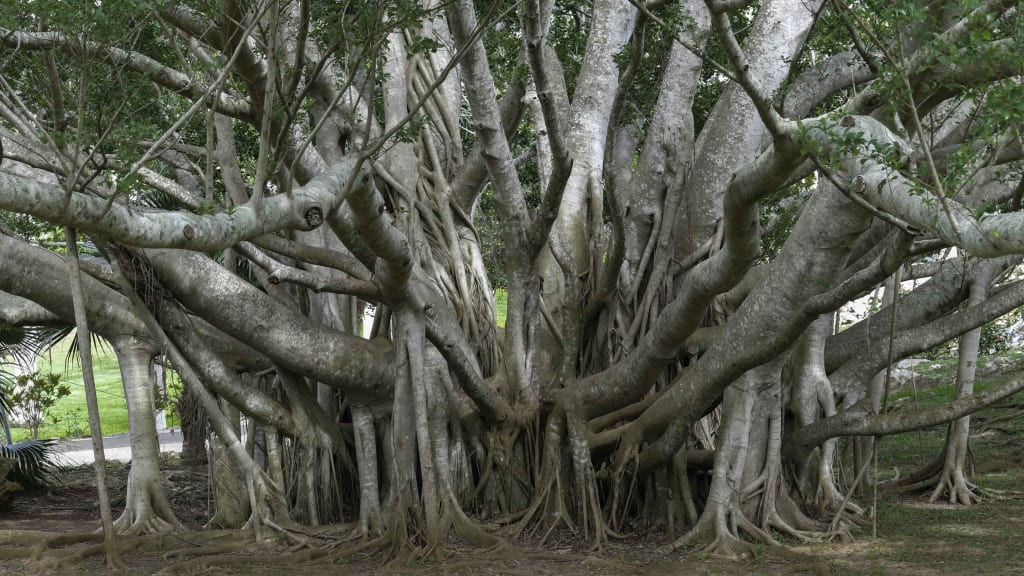Great Banyan tree
Can cover an area of up to 1.5 acres

The Great Banyan tree is a species of banyan tree that is native to the Indian subcontinent. It is known for its large size and wide-spreading branches, which can cover an area of up to 1.5 acres. The tree is considered to be one of the largest trees in the world and is a popular tourist attraction in the Botanical Garden of Howrah, West Bengal, India.
The Great Banyan tree is a type of fig tree and is a member of the Moraceae family. It is a deciduous tree that can grow to be over 100 feet tall and can live for over 300 years. The tree is known for its aerial roots that grow from the branches and eventually reach the ground. These aerial roots eventually grow into new trunks, giving the tree the appearance of being a grove of trees rather than a single tree.
The Great Banyan tree is a hardy tree that can grow in a variety of soil types, including sandy and clay soils. It is tolerant of drought and can survive in areas with low rainfall. The tree prefers full sunlight and can grow in a wide range of temperatures.
The Great Banyan tree is an important source of food and shelter for many animals and birds. The tree is a popular roosting spot for bats and is also home to many species of birds, including parakeets, mynas, and hornbills. The tree's fruit is a favorite food of monkeys and elephants.
The Great Banyan tree is also an important source of medicine. The bark of the tree is used to treat a variety of ailments, including fever and diarrhea. The tree's leaves are also used to make a medicinal oil that is used to treat skin conditions.
The Great Banyan tree is a protected species in India and is considered to be a national treasure. The tree is also listed as a "heritage tree" by the Indian government. Efforts are being made to preserve the tree and its surrounding environment, including the creation of a protective barrier around the tree and the planting of other trees to provide shade and shelter.
In conclusion, the Great Banyan tree is a unique and important species that plays a vital role in the ecosystem of the Indian subcontinent. Its size and spread, along with its long life span make it an important tourism spot and a national heritage. It provides food, shelter, and medicine for many species and is an important symbol of the region's natural heritage.
The banyan tree, also known as the "strangler fig," is a type of fig tree that is native to India and other parts of Southeast Asia. Banyans are known for their distinctive aerial roots that grow from the branches and eventually reach the ground, where they take root and become new trunks. This allows the banyan tree to grow into a large, spreading tree with multiple trunks.
The life of a banyan tree begins as a small seed that is dispersed by birds or bats. The seed germinates and grows into a small plant that eventually reaches a height of several feet. As the plant grows, it begins to produce aerial roots, which grow downward from the branches and eventually reach the ground. These aerial roots take root in the soil and become new trunks, allowing the banyan tree to spread and grow larger.
As the banyan tree continues to grow, it may eventually reach a height of up to 100 feet or more. The tree's canopy can span over several thousand square feet, providing shade for many animals and plants that live beneath it. The tree's branches may be supported by as many as several hundred aerial roots, which give the banyan tree a distinctive, spreading shape.
One of the most fascinating things about banyan trees is the way that they spread and grow. As the tree's aerial roots reach the ground, they take root and become new trunks, allowing the banyan tree to spread and grow larger. This process can continue for many years, and it is not uncommon for banyan trees to have dozens of trunks by the time they reach maturity.
Banyan trees are also known for their long lifespan. Some banyan trees are believed to be over 2,000 years old, making them one of the oldest living organisms on Earth.
Banyan trees are also considered to be sacred in many cultures, including Hinduism and Buddhism. In Hinduism, the banyan tree is considered to be a symbol of immortality and is often associated with the god Vishnu. In Buddhism, the banyan tree is associated with the Buddha and is believed to be the tree under which he attained enlightenment.
Banyan trees also play an important role in the ecosystem. They provide food and shelter for a wide variety of animals and plants, including birds, monkeys, bats, and insects. The tree's aerial roots also help to stabilize the soil and prevent erosion.
In conclusion, Banyan tree is a fascinating species with a unique growth pattern, long lifespan, and cultural significance. They play an important role in the ecosystem, providing food and shelter for many animals and plants and helping to stabilize the soil. They are also considered sacred in many cultures, making them an important symbol of immortality and enlightenment.
About the Creator
Gajendira Kumar
I am Not a Legend I am the Lengends Maker by GAJAJI
Content Creator
Future Technology






Comments
There are no comments for this story
Be the first to respond and start the conversation.